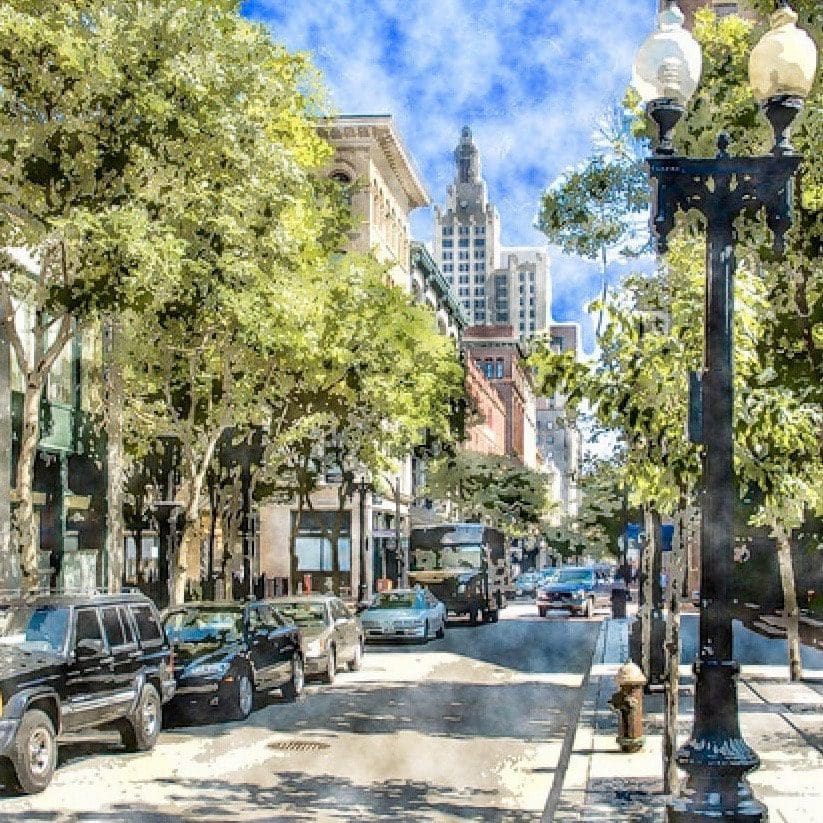Search Posts
Recent Posts
- Detailing Manhattan: Christopher Gray’s Legacy – David Brussat April 26, 2024
- Business Beat: BankNewport supports Kids’ Zone at new Save The Bay Hamilton Family Aquarium April 26, 2024
- Rhode Island Weather for April 26, 2024 – John Donnelly April 26, 2024
- GriefSPEAK: Dread. Fear. Welcome relief. – Mari Nardolillo Dias April 26, 2024
- Outdoors in RI: big animals, tiny Ticks, huge Trout, Chepachet’s Harmony Railway, 2A – Jeff Gross April 26, 2024
Categories
Subscribe!
Thanks for subscribing! Please check your email for further instructions.

For one or two-way streets?
All drivers become pedestrians when they emerge from behind the wheel
For one or two-way streets?
By David Brussat, Architecture Here and There
On a recent sojourn in (and above) Manhattan, Steve Mouzon sparked a Facebook conversation about the merits and demerits of one- and two-way streets. It unfolded at such a high level of thoughtfulness about streets (of either ilk) from so many places – not just the Big Apple – that Mouzon decided to put the whole discussion on his blog, known as “The Original Green,” after his pathbreaking book of the same name (purchase it via his website). In light of street changes in Providence, I hereby link from my blog to the conversation on his blog (“New Urbanists on One-Way Streets“).
Mouzon got the ball rolling with this question: “To all my #NewUrbanist colleagues who feel that one-way streets are terrible, why is Manhattan not a wretched, dysfunctional place?”
(The number of those who would insist that Manhattan is indeed a wretched, dysfunctional place may not be legion, but it is also not inconsiderable. I hasten to add that I do not count myself among them.)
Providence’s historic downtown is, I think, still the only entire metropolitan downtown in America on the National Register of Historic Places. Since 1990, it has had the benefit of planning charrettes from New Urbanist guru Andrés Duany, and Liz Plater-Zyberk, his wife, partner and co-winner of the Driehaus Prize. One of their recommendations arose from the city’s mania for one-way streets during the urban-renewal era of the 1950s and 1960s. A one-way street was said to facilitate traffic speeding through our increasingly destitute downtowns. Duany urged Providence to turn some of those one-ways into two-ways. That has been done on major stretches of Washington, Weybosset, Empire, a brief stretch of lengthy Dorrance and the brief extent of Exchange Terrace. It ought to be done as well on Fountain and Sabin, which are both unnecessarily wide.
Providence’s main commercial thoroughfare, Westminster, is still one-way because it is not wide enough to be any other thing. Duany once stated that Westminster reflects the perfect ratio of street width to building height. It creates a maximum sense of enclosure and hence comfort for pedestrians. That is one reason it is among the most beautiful city streets in America and maybe the world, although I would stress the importance of lining a street with traditional architecture, which almost all downtown Providence streets have in abundance. A street with a perfect width-to-height ratio lined with modernist buildings would not be impressive but oppressive. (I wonder whether Duany would still agree with this.)
Ian Manire, an architect with Union Studios in downtown Providence, joined the Mouzonian conversation:
Lived in downtown Portland for years and because of the small blocks and pedestrian-speed traffic, it was immensely walkable and human-oriented. I now live between two one-way “thoroughfares” on the East Side of Providence, R.I., and it’s also lovely – because the streets are one-lane narrow road bed with naturally slowed automobile traffic. All about street scale and tighter grid-weave.
I am guessing that Manire lives between Angell and Waterman, which cross College Hill between downtown and the Seekonk River. For “thoroughfares,” Angell and Waterman are narrow, though not as narrow as most streets on deeply historic and profoundly beautiful College Hill.
More two-way streets have made it easier to get around downtown Providence by car, and without degrading the pedestrian experience. Its street grid is not as systematic as that of Manhattan, where most crosstown streets are one way and so are most north-south avenues. Not that making it easier for cars to get around is near the top of most New Urbanists’ agendas, but it ought to be a goal if it can be done without unprivileged pedestrians. After all, whether you happen to be in Manhattan or Providence, all drivers become pedestrians when they emerge from behind the wheel, and all cities are dependent on those drivers.
In our understandable urge to help pedestrians get out from under the dystopias created by city planners in the urban-renewal era, we sometimes went too far. (“We”? What you mean “we,” Kemosabe?) In cities whose streetscapes are “historic,” the question of one- or two-way streets is moot, because beauty heals most wounds arising from mere traffic patterns. Needless to say, planning offices almost entirely neglect the importance of beauty to the well-being of both pedestrians and drivers in cities.
More dangerous to Manhattan’s walkability than traffic patterns is the ubiquity of scaffolding on buildings along streets almost everywhere. (See “The streets of New York” from last May.) Some may think the hazard is to the heads of pedestrians, but it is really to the eyes of pedestrians and drivers alike. I believe downtown Providence has only one building marred by scaffolding, but it is the Industrial Trust (“Superman”) Building of 1928. That’s the distant tall building with setbacks in the photo atop this post. It has been vacant since 2013. An occupant must be found, yes, but maybe removing the sidewalk scaffolding would help. It makes little difference that Westminster and Fulton streets are one-way on either side of the building.
David Brussat writes a frequent blog on architecture, Architecture Here and There. Follow his blog at: https://architecturehereandthere.com
